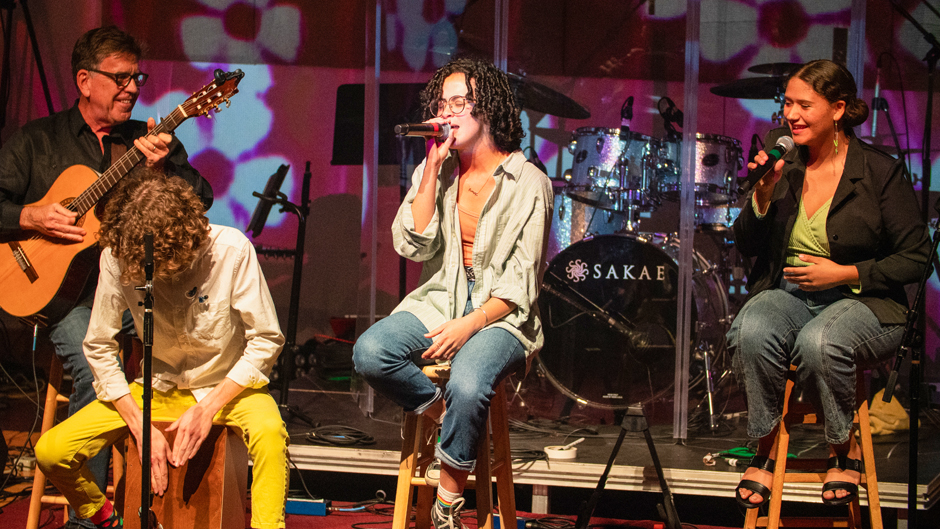While Hispanic Heritage Month could be celebrated all year in the United States, the holiday was originally meant to coincide with the independence of several Latin American countries. Today, it serves as a reminder to celebrate the many contributions of the nation’s fastest growing demographic.
The following snippets spotlight a few members of the University of Miami faculty, who hail from countries where Spanish or Portuguese is spoken and are esteemed writers, artists, and musicians who have incorporated their background into their work.
-
Chantel Acevedo
Chantel Acevedo, a professor of English and director of the Creative Writing program, was born in Miami to Cuban parents.
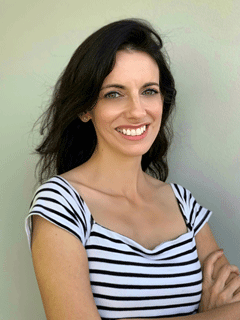
She is also the author of seven books of fiction, including two middle grade books. Growing up in Hialeah, Acevedo often learned about her Cuban background from her grandmother, who told her about life in the island nation and encouraged her to read and memorize poems from José Martí, a Cuban nationalist writer, philosopher, and journalist. It was from these stories that Acevedo often imagined her parents’ homeland and learned about her own extended family too. As a result, Cuban characters and settings are fused into her books and characters.
“Writing about Cubans and Cuban Americans is also an act of empowerment,” she said. “In the vast number of pages published each year, so few are about my community that I feel I must represent it.”
Acevedo said that she feels fortunate she can share a snapshot of her heritage with readers, and she suggested her students do the same.
“I encourage emerging writers to be fearless in their work, particularly as it relates to telling the stories of the places they come from and the people who have shaped them,” she said. “I often tell students how it felt for me as an undergraduate, not yet aware that the stories about my community were worthy of literature, and how much my own writing grew and developed when that notion became clear to me. Through this example, I urge them to write about their own cultures and languages with pride.”
-
Carlos Llerena Aguirre
Carlos Llerena Aguirre is an artist and professor of art and art history, who specializes in illustrating, woodcutting, printmaking, and filmmaking. He has represented Peru and the U.S. in eleven international exhibitions, called biennales, and has 16 official selections in international film festivals. Music is another one of his passions, and Llerena Aguirre also plays a notched Andean flute called the “quena.”
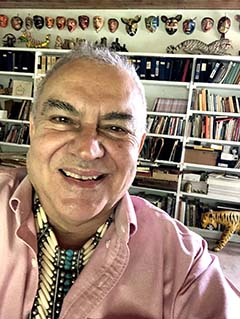
Llerena Aguirre was born in Arequipa, a city in southeastern Peru, where he grew up fascinated by traditional carved gourds that featured narratives, as well as “retablos,” or Peruvian folk art boxes that open to reveal colorful village scenes. When he was 7, Llerena Aguirre’s family moved to Lima, where he went to school, sketched, and dabbled in woodcutting after discovering the work of José Sabogal, until moving to New York City for college. It was at the School of Visual Arts and the City University of New York that Llerena Aguirre learned more about the woodcuts of Mexican artist José Guadalupe Posada and refined his drawing skills using Spanish artist Francisco Goya’s etchings. During the 1980s, Llerena Aguirre worked as a freelance artist and produced illustrations, prints, or woodcuts for articles in the New York Times and the Village Voice.
Now an American citizen, Llerena Aguirre grew up speaking Spanish and Quechua, which is the native language and name of an Indigenous group that inhabits Peru, Bolivia, Ecuador, and the Amazon. As a result, Llerena Aguirre often explores themes of his heritage and the significance of nature in his visual art and films, including a feature he now is finishing about Inca rope bridges and another about Incan masks.
As a result of these immersive experiences in Peru, Llerena Aguirre said he tries to teach his students to respect their cultures and to spark others’ interest through art.
“My first years as a teacher allowed me to print during the weekends, and this art was influenced by the iconography from Peru or dealt with the terrorism there,” he said, referring to the Shining Path insurgent group that killed an estimated 70,000 Peruvians between 1980 and 1992. “Similarly, I try to teach my students to influence or help others learn through their art.”
-
Reynaldo "Rey" Sanchez
Reynaldo “Rey” Sanchez is associate dean for strategic initiatives and innovation at the Frost School of Music. He is a guitarist, musical scholar, producer, and songwriter. Born in Havana, Cuba, Sanchez left at the age of 5 and grew up in the Midwest. That’s where he honed his guitar-playing skills listening to rock, blues, and Americana and favored artists like Carlos Santana, Jimi Hendrix, and Eric Clapton.
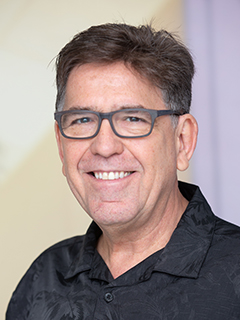
Sanchez’ parents always required Spanish to be spoken at home and often played Cuban and other Latin music. They worked hard to maintain their culture at home for Sanchez and his sisters. After graduating from what is now the Frost School, Sanchez served as musical director and guitarist for Puerto Rican singer, Chayanne, and other Latin artists. Sanchez spent more than 20 years touring through South and Central America, the Caribbean, and Spain, delving deeply into his background and connecting with Hispanic music and culture in significant ways.
Today, Sanchez directs the Bruce Hornsby Creative American Music (CAM) Program, the Frost School’s renowned songwriting artist program.
Five years ago, Sanchez started a Latin singer-songwriters ensemble at the Frost School called “Café con Leche,” which attracts students with Hispanic backgrounds, as well as others interested in exploring original Latin music. He said that as Latin music continues to grow in popularity—like the recent astronomic rise of Mexican singer Peso Pluma—students’ interest in creating and playing that music will increase, too.
“It’s so much fun to introduce students to these genres,” he said. “One of my students grew up in Minneapolis, but her family is from Panama. So, this ensemble has really helped her connect with her roots.”
While growing up, Sanchez said he may not have fully appreciated his bicultural heritage; but later on, he was glad that he could navigate both languages and cultures. It provided many professional opportunities, allowing him to play and record with numerous Latin artists.
“If musicians can cut across styles, as I was able to do, they can work in many different and interesting situations,” he said.
Still, Sanchez noted, when talking about Hispanic Heritage month, it’s important to never stereotype a certain background.
“Hispanic culture is not one dimensional,” he said. “One must understand the mosaic that is Hispanic culture: deep, rich, and varied. To say it’s diverse is almost an understatement. It continues to evolve in significant ways, and the contributions of Hispanic culture and music to the world have been astonishing.”
-
Mia Leonin
Mia Leonin, a senior lecturer in the creative writing program, and poet, grew up in the rural town of Marshall, Missouri. But when she came to graduate school at the University of Miami, Leonin was able to connect with her father’s Cuban roots and began to learn the language of her paternal family. She even spent some time living in Colombia, so that she could improve her Spanish-speaking skills and teach English. Leonin said the experience helped her to understand the culture and nuances of language.

Now an author of four poetry books and one memoir, Leonin often writes with an interplay of Spanish and English that, to many, is simply part of living in the greater Miami region. She uses her unique perspective—as a girl raised by a mother from Kentucky, but who today calls Miami home—to explore themes about feminism, gender roles, motherhood, immigration, and assimilation.
“Coming to Miami wasn’t just to learn about poetry, but to learn and grow into my own identity. And a byproduct of that was my observations about the language and my learning of it,” she said. “Engaging with Miami was a way of learning about my history and also claiming my own unique place in that and writing about it.”
Leonin also immersed herself in Cuban culture by attending and later reviewing Spanish-language theater for the Miami New Times and the Miami Herald before joining the faculty at the University.
She said that she is glad that her journey to South Florida for graduate school allowed her to connect with her heritage, as it has shaped her life and work. This is highlighted in “How to Name a City,” Leonin’s poem about Miami.
“Because I became fluent in Spanish as an adult and because of the way my mind works with language, I was able to see Spanish from the inside looking out, as well as the outside looking in,” she said. “It very much affects the poems I write . . . for example, in the book ‘Chance Born’ I took sayings in Spanish and translated then in English as a poetic way of playing around with the meanings.”
In her classes, Leonin often uses the work of poets she respects and admires from the area to expose her students to contemporary poetry. Coincidentally, these poets are often Hispanic or LatinX. She often uses Caridad Moro Gronlier’s “Tortillera,” or Alexandra Lytton Regalado’s “Matria” in class. But she hopes that all University students will make a point to expose themselves to the vibrant Hispanic culture in this “gateway to the Americas.”
“UM is a bubble within Miami, which is a highly stratified place, divided by socioeconomic class, race, and ethnicity. Therefore, sometimes students miss out on opportunities to engage with our really rich cultural communities and experiences, and one of those is the LatinX community in Miami,” she said. “Nobody comes here and doesn’t go to the beach, but the culture here is as important to see as the ocean and the beach.”
-
Camilo Rodriguez
Camilo Rodriguez, a lecturer in the Frost School’s Department of Media, Scoring, and Production, is an award-winning music producer, bassist, guitarist, and pianist whose music has been featured in movies and films, as well as many television shows.
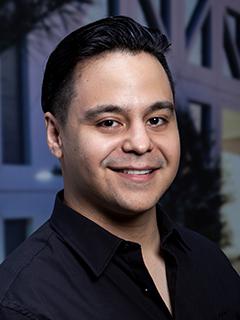
Rodriguez grew up in Barranquilla, Colombia, but came to the U.S. as a young adult to attend Berklee College of Music in Boston. After those four years, he returned to his home country, worked at a major recording studio, and then realized he wanted to create music for films. So, Rodriguez came back to the U.S. to complete a Master in Media Writing and Production at the Frost School. When he graduated, there was an opportunity to teach, so Rodriguez decided to stay in Miami but regularly takes the two-hour flight home to visit family or to work a gig.
“I follow a lot of musicians that are still there and work projects and events, like Carnaval,” he said.
In between teaching Frost School classes, Rodriguez also produces his own music, which has been featured on major television networks like Bravo, as well as streaming services like Amazon Prime Video. Rodriguez is also a musical composer for independent films and produced and mixed all of the music for the film “South Beach Love” that aired on Hallmark in 2021.
One of his favorite projects was creating and producing the theme song for the 2018 “Juegos Centramericanos y del Caribe,” also known as the Caribbean Olympics, which was hosted in Baranquilla. It gave him a chance to create a song that was listened to by millions of people, he noted.
As a child, Rodriguez said he was influenced by Dominican musician, singer, and composer Juan Luis Guerra; U.S. guitarist John Mayer; and Colombian singer-songwriter Carlos Vives, who sang the theme song for the Disney movie “Encanto.”
While Rodriguez appreciates all forms of music, he said that he is glad that in recent years Latin American music and culture were showcased in popular children’s movies like “Encanto,” based on a Colombian family, or “Coco,” based on a Mexican family. These are helping to make Hispanic culture more accessible to everyone in the U.S., he pointed out.
“When more films and music that are more inclusive are coming out, that’s good because it invites other people to listen to Latin music or see parts of our culture celebrated in movies,” Rodriguez said. “This opens the door for new music, films, and art to be accessible to the general public.”
